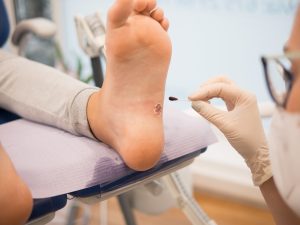
What are verruca?
Verruca are plantar warts that commonly occur on the soles of the feet or around the toe area. They are caused by the Human Papilloma Virus (HPV), which is contagious through direct person-to-person contact. There are various forms of HPV, which all relate to various parts of the human body.
What causes verruca?
The HPV virus is thought to thrive in moist, damp environments such as swimming pools, changing room floors and communal shower areas. It is possible to contract verrucae simply by walking across the same floor area as someone with a verruca, especially if you have any small or invisible cuts or abrasions that make it easier for the virus to penetrate.
Who gets them?
Verruca are most commonly seen in children, teenagers and young adults, largely those who use communal changing rooms. It is possible to develop an immunity against the virus over time but most people remain susceptible, although some more than others.
How do I know I have them?
The most common appearance is that of a small cauliflower-type growth on the soles of your feet with tiny black dots. If it is painful when you pinch the area (like when you squeeze a spot), you are likely to have a verruca. They can grow to 1cm in diameter and may spread into a cluster of small warts. If you are unsure, seek advice from a podiatrist.
Are they serious?
Verruca are harmless but can be uncomfortable and painful if they develop on a weight bearing part of the foot. In addition, hard skin (callus) can form over the top of the verruca, increasing the discomfort in this area. There are also some strains of the virus that spread very quickly and can look unsightly.
What are the treatments?
In the first instance, avoid touching or scratching a verruca as it may spread into a cluster of warts. Instead, cover it up with a plaster. In many cases, evidence suggests that verrucae will disappear of their own accord within six months for children but longer for adults (up to two years). This is because the body’s immune system recognises the presence of the virus and fights the infection naturally but it can take many months for this to happen. If it is painless, no treatment may be required as some treatments can be painful especially for children and can cause side-effects.
For painful and/or unsightly verrucae or ones that are spreading, you can self-treat using ointments and gels from your local pharmacist following the instructions carefully. Sometimes, merely by rubbing away the dry skin over a verruca and applying a plaster helps to stimulate the body’s immune system to fight the infection. However, if your verruca becomes unusually painful or the surrounding skin area goes red, stop treatment immediately and see a podiatrist. This is because if the healthy tissue around a verruca is damaged, you could hamper further treatment.
The College of Podiatry. Common Foot Problems. Viewed 11 October 2020, https://cop.org.uk/common-foot-problems
View our Verruca Treatments

